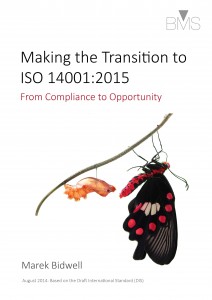 This page outlines 13 of the key changes in ISO 14001. As you read through, consider which are likely to be the most relevant to your organisation, which will require the most amount of change to your systems, and which will deliver the greatest environmental benefits:
This page outlines 13 of the key changes in ISO 14001. As you read through, consider which are likely to be the most relevant to your organisation, which will require the most amount of change to your systems, and which will deliver the greatest environmental benefits:
Structure of the standard: There will be changes to the structure of the standard in accordance with ISO’s new High Level Structure (Annex SL). There are 7 main sections: 4) Context of the organization, 5) Leadership, 6) Planning, 7) Support, 8) Operation, 9) Performance Evaluation, 10) Improvement
Understanding the organisation and its context: A requirement to determine the environmental context of your organisation (4.1). This means identifying internal and external issues that may affect the intended outcomes of its environmental management system, and also external environmental conditions that may affect, or be affected by the organization.
Interested parties: A requirement to determine the needs and expectations of interested parties from an environmental point of view (4.2).
Leadership and commitment: Increased focus on the role of top management. This includes ensuring compatibility between environmental policy and the organisation’s strategic direction, and taking accountability for the effectiveness of the environmental management system (5.1).
Environmental policy: Make additional commitments in the policy to ‘protection of the environment’ specific to your organisation (5.2). These commitments may include issues such as sustainable resource use, climate change mitigation and adaptation, and protection of biodiversity and ecosystems.
Risks and opportunities: Determine the risk (to the organization, and the environmental management system) associated with threats and opportunities, including those arising from external environmental conditions (6.1.4). The output of context analysis feeds into this requirement.
Environmental objectives: More detailed and specific environmental management programmes: what will be done, resources required, who will be responsible, when it will be completed, and how results evaluated, how it will be integrated with business processes (6.2.2).
Competence: A requirement to evaluate the effectiveness of actions taken to acquire competence (7.2),
Communication: A requirement to plan communications, taking into account interest parties (7.4) - this may require additional external reporting. And a requirement to ensure the ‘reliability’ of external communications (7.4) – this may require increased data verification.
Value chain: upstream (procurement): Consider a life-cycle perspective when identifying environmental aspects (6.1.2), and determine environmental requirements for the procurement of products and services (8.2).
Value chain: design and downstream: Consider a life-cycle perspective when identifying environmental aspects (6.1.2); establish controls to ensure that environmental requirements are considered at each stage of your product, or service’s, life-cycle: design process, development, delivery, use, and end-of-life; communicate relevant information to external providers and contractors; and provide information about the environmental impacts of your products (8.1).
Performance evaluation: An enhanced level of monitoring, measurement, analysis and evaluation; and a requirement to determine methods to ensure valid results (9.1.1).
Compliance status: Maintain knowledge of compliance status (9.1.2). This is in addition to the existing requirement to evaluate compliance.
You must be logged in to post a comment.